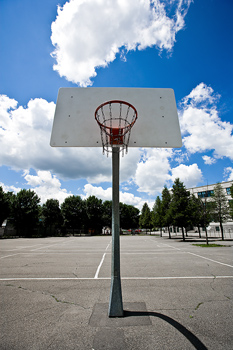How to Play Basketball
The game of basketball was created not long before the turn of the 20th century, meaning that it is quite young when compared to other popular sports. However, that hasn’t stopped it from becoming one of the most widely played and widely watched sports in the entire world. The game was created as the brainchild of Dr. James Naismith, a physical education professor who wanted to develop a new game for his class to enjoy on a rainy day. The game of basketball has come a long way since then, changing dramatically over time to become the game we know today. One possible explanation for basketball’s immense popularity is that it can be played virtually anywhere – the only essential elements are a ball and a hoop. It’s these qualities that make learning how to play basketball a simples process.
Basketball – An Overview
In short, basketball is a team game in which opposing squads try to throw a leather or rubber basketball through a hoop suspended 10 feet in the air. Doing so scores points and the team with the most points at the end of the game wins. A regulation court size, according to the National Basketball Association or NBA, is 94 feet long by 50 feet wide. The court is typically made of a hardwood like maple. However, synthetic floor materials are popular at the recreational level. Both teams on a basketball court will have five players playing at one time although many teams are composed of up to fifteen players, as substitutions can occur frequently.
The duration of the game varies depending on the league. NBA basketball consists of four 12-minute quarters. College games consist of 20-minute halves and high school games are played in eight-minute quarters. Men use a basketball that weighs 22 oz. and is 29.5 inches in circumference. The women’s ball is slightly smaller with a circumference of 28.5 inches and a weight of 20 oz. The basketball rim is 18 inches across with a net suspended below it and hangs on a backboard.
Teams are awarded one point for a successful free throw (an uncontested shot taken from the fifteen-foot foul line), three points for shots taken behind the three-point arc and two points for shots made anywhere inside the arc.
Rules of Basketball

How to Play Basketball
Double dribbling (or dribbling the ball with both hands) is a violation and a turnover. If a player obstructs the path of a ball on its way downward motion toward the hoop, a goaltending violation has occurred resulting in a change of possession and the points being counted.
A player commits a foul when he or she has used excessive contact against an opponent. If the foul occurred in the act of shooting, the player who was fouled is awarded two free throws (or three if the player attempted the shot from behind the three-point line). If the team on defense committed the foul and no shot was attempted, the offense retains possession by in-bounding the ball from the sideline or baseline. If the team on offense committed the foul, they forfeit the possession.
Basic Skills
Shooting is probably the most important skill in the game of basketball and coaches emphasize it from an early age. A player is considered quite successful if he or she can make about 50 percent of all shots from the floor. Dribbling and passing are key skills to acquire to effectively move the ball on offense. Defense is also critical and many high school and college practices are devoted almost entirely to the practice of guarding both the player with the ball and the players without it. Rebounding, or retrieving the ball after a missed shot is an important component of the game as it can provide second chances on offense and limit opponents’ chances while on defense.
Basketball Positions and Tactics
While no positions are specified in the game’s rules, some basic positions have naturally evolved. Most teams are made up of two guards, two forwards and one center. Guards are typically fast players with good ball handling skills. The point guard sets up the offense and is usually responsible for dribbling the ball up the court. The shooting guard should also be quick with good ball handling and shooting skills. The two forwards on a team are typically relatively tall and their function is to create good shots from near the hoop and rebound. The center is usually a team’s biggest or tallest player and remains near the hoop on the offensive and defensive ends of the court.
Most basketball teams employ one of two basic defensive strategies. A “man” defense involves every player on the defensive team guarding a specific player on the offense. A “zone” defense mandates that each player is responsible for a certain area of the court on defense.
Although the game of basketball is fairly simple to learn, its many strategies and minor rules can make it a game that players spend a lifetime perfecting.
